Recycled Aggregates: Uses and Benefits
Recycled aggregates are granular materials that are typically derived from construction, demolition, and excavation waste (CDEW) and repurposed in future projects. These recycled materials support sustainable construction practices by ensuring fewer materials are wasted and end up in landfill. An added benefit is that there is no need to source and transport expensive primary aggregates, which have a high carbon cost, generating cost efficiencies and helping companies to make significant carbon savings.
In the UK, considerable efforts have been put into encouraging and facilitating the use of quality recycled aggregates. The most recent data obtained by the Mineral Products Association (MPA) suggest that almost all UK construction demolition and excavation waste (CDEW) including track ballast, which is suitable for use as aggregate is now being recycled. Contributing just over 30% of all aggregates used in UK construction.
However, the construction industry worldwide still relies far too heavily on the usage of newly extracted aggregates, redressing this imbalance in favour of recycled materials will play a key role in global efforts to tackle the climate crisis as we look to create more sustainable infrastructure solutions. And as we’ll see over the course of this article, businesses can also make worthwhile commercial gains by using recycled aggregates.
Read on to discover more about what recycled aggregates are, their uses in construction projects, and the environmental and commercial benefits. Along the way, we’ll also explore the different types of recycled aggregates and what each specific material is used for, before considering the challenges posed by using recycled aggregates and solutions to overcome them.
Looking for something in particular? Use the links below to navigate straight to it:
- What are recycled aggregates?
- Types of recycled aggregates
- What can recycled aggregates be used for?
- Benefits of recycled aggregates
- Challenges of recycled aggregates
- Case study: Royal Docks, London
- How Tensar can help
Tensar geogrids help your business make substantial cost and carbon savings by opening up the opportunity to make more efficient use of primary and recycled aggregates when constructing roads, working platforms and reinforced soil retaining walls and slopes. To discuss your next project, get in touch.
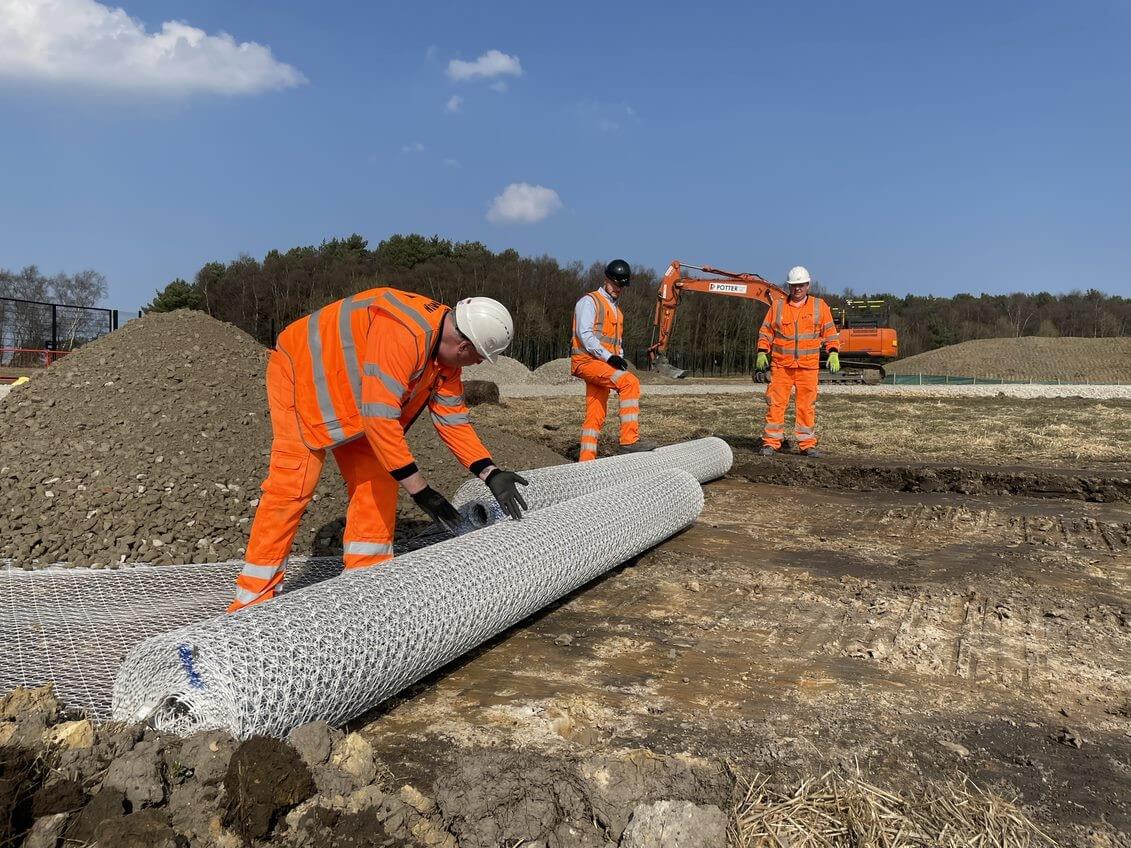.jpeg)
Tensar’s InterAx geogrid can be used to stabilise recycled aggregates to improve their performance in engineered applications, decreasing the need to use more costly primary aggregates.
What are recycled aggregates?
Recycled aggregates are crushed and processed materials derived from previous construction projects, reused as construction aggregates in new projects. They enable a more sustainable approach to construction, reducing the need to extract, process, and transport primary aggregates whilst preventing demolition and construction waste from ending up in landfill.
These recycled materials may include crushed concrete, brick, glass, and ceramics, which are reclaimed from demolition or construction waste. The use of recycled aggregates will help to reduce negative impacts that construction activity has on the environment, enabling us to work towards a sustainable future together. It’s also a win-win for businesses, as they can make cost savings in the process.
In this episode of Ask Andrew, he visits Kansas City to answer the question "What are the benefits of using geogrids with recycled aggregates"
Recycled aggregates vs secondary aggregates
Whilst similar in use, recycled aggregates and secondary aggregates are different.
Recycled aggregates are materials derived from the waste of a construction project or demolition, whilst secondary aggregates are produced from waste arising from industrial processes. They are then repurposed as construction materials. Examples of secondary aggregates sources are mine waste, slag, and fuel ash.
One thing these materials do have in common is how they are utilised to reduce waste and offer a more environmentally friendly alternative compared to the use of newly extracted primary aggregates. You can read more about the different types of aggregate and their uses in this article.
Types of recycled aggregates
When it comes to sourcing materials for recycling as aggregate for construction projects, there is a selection of recycled aggregate types to choose from. In this section, we’ll look into the main types identified by European Waste Catalogue (EWC) codes for hard inert CDEW..
Concrete (EWC code 17.01.01)
Crushed concrete is one of the most used recycled aggregates in construction. Referred to as recycled concrete aggregate (RCA), it can be used as a replacement for primary aggregate in the production of new concrete. Not only is it a more sustainable option, but it’s also cost-effective compared to primary aggregates. We’ve also seen this quality material put to good use in road construction projects over recent years.
Brick (EWC code 17.01.02)
Crushed brick is usually sourced from the demolition waste of buildings, with common applications ranging from driveways and pavements to drainage systems. While not suitable for use in concrete production it has many uses in road and drainage applications. It is also an excellent material for use as structural fill in TensarTech reinforced soil retaining walls.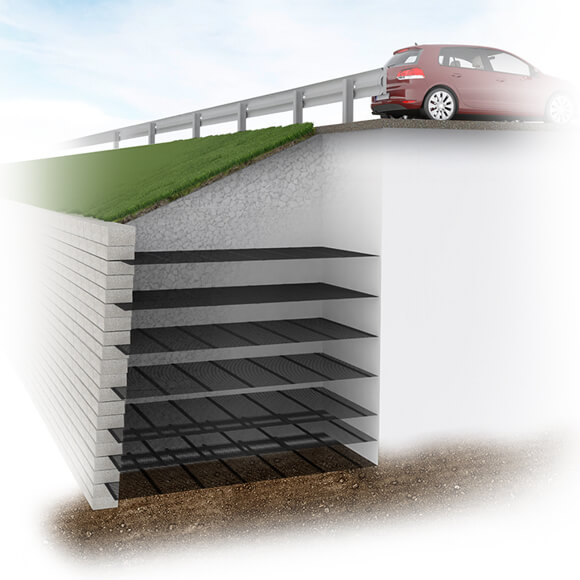 TensarTech retaining wall reinforcement can incorporate crushed brick as a fill material, offering cost and carbon savings.
TensarTech retaining wall reinforcement can incorporate crushed brick as a fill material, offering cost and carbon savings.
Tile and Ceramics (EWC code 17.01.03)
Floor tiles, wall tiles, and bathroom ceramics are a common component of demolition waste. Hard and durable, they are a desirable constituent in recycled aggregates. They would usually form part of a mixed source recycled aggregate for use in roads and drainage works.
Rubble – Mixtures of materials (EWC code 17.01.07)
This term is used to describe mixed material obtained from demolition, which may include concrete, brick, tiles, and ceramics. Recycled rubble is a sustainable and cost-effective choice of aggregate often used as a subbase for road construction and foundations. There may be some material in the mixture that is not desirable, e.g. wood, plastic, and metal. The maximum allowable content must be defined – typically not more than 1% by weight.
Track Ballast (EWC code 17.01.08)
Rail track ballast degrades over time due to repeated heavy loading. The particles become rounded and contaminated with fine particles. While Tensar geogrids in trackbed construction can delay the problem, eventually ballast may need complete replacement. The removed ballast is suitable for processing into recycled aggregates, suitable for used in road foundations and rail trackbed.
Glass (EWC code 17.02.02)
Crushed glass is a hard material with consistent quality. When processed, it can be recycled for use in concrete production and road construction. Recycling of glass prevents the wastage of glass that would otherwise end up in landfill. It also cuts costs by reducing the quantities of primary aggregate needed in a project.
Asphalt (EWC code 17.03.02)
Reclaimed asphalt is most commonly obtained from the removal of aged road surfacing, usually by milling or planing. While it can be used in limited proportions together with other recycled aggregates for road foundations, it is most valuable when used as a constituent in asphalt mixes for resurfacing roads. There are multiple asphalt mix types used within the construction industry – head over to our article on asphalt pavement design.
What can recycled aggregates be used for?
There are many applications of recycled aggregates in construction, offering a sustainable and more cost-effective alternative to primary aggregates, including:
- Roads and trafficked areas: Used in conjunction with geogrids to provide strength and stability to the road foundation
- Unsurfaced roads: Creates a durable foundation for temporary roads.
- Railway and trackbed improvements: Enhances the stability and durability of rail tracks.
- Working platforms: Provides a sturdy level base for construction equipment and crane operation.
- Subgrade and ground stabilisation: Distributes load over weak soil whilst creating stability for construction projects.
- Foundation support: As a fill in TensarTech Stratum Foundation Mattress system or mechanically stabilised layer foundation.
- Reinforced soil retaining walls and slopes: Used as structural fill material in reinforced soil walls or slopes in landscaping and infrastructure projects.
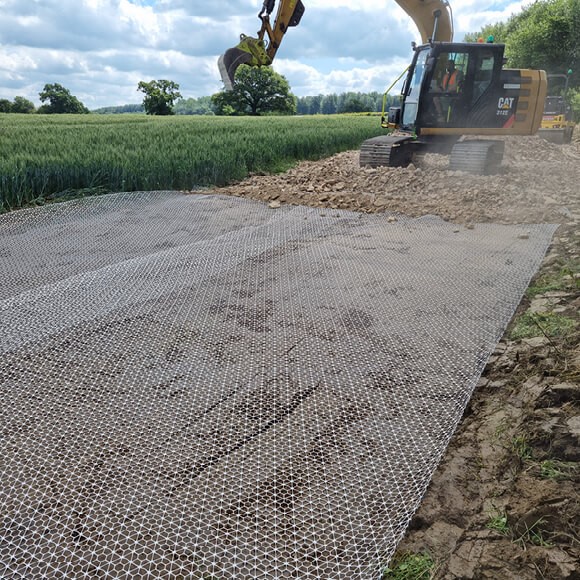 On this access road project, the combination of Tensar InterAx geogrid and recycled aggregate achieved a 32% reduction in construction cost, a 1.2 day reduction in construction time, along with a 47% (9,90kg CO2e) reduction in environmental cost.
On this access road project, the combination of Tensar InterAx geogrid and recycled aggregate achieved a 32% reduction in construction cost, a 1.2 day reduction in construction time, along with a 47% (9,90kg CO2e) reduction in environmental cost.
Standards for recycled aggregate use in construction
Recycled aggregate use in new concrete
The British/European product Standard for aggregates for concrete production (BS EN 12620) does not distinguish between primary, secondary (manufactured) or recycled aggregates. However, BS 8500 (complementary UK Standard to BS EN 206) does set out conditions for the use of recycled aggregates in new concrete construction that are product-specific and specification -specific. For example, in some Designated mixes the proportion of crushed concrete aggregate (CCA) is limited to a maximum of 20%. For Designed mixes there are no restrictions provided durability criteria are met.
Recycled aggregate use in highway works
The Manual of Contract Documents for Highway Works (MCDHW)– Volume 1, which sets out standards for highways in the UK, allows for the use of recycled aggregates in a number of application areas. In all cases the material must be tested in accordance with Clause 710 to classify the constituents, follow the Quality Control Procedure in that clause, and must conform to BS EN 13242 ‘Aggregates for unbound and hydraulically bound materials for use in civil engineering work and road construction.’ There may be a small proportion of undesirable material allowed in recycled aggregate mixtures, e.g. wood, plastic, and metal. MCDHW refers to this as Class X material. Where it is accepted, the maximum allowable content is limited to not more than 1% by weight.
Earthworks
MCDHW distinguishes between two types of recycled material.
- Recycled aggregate – processed CDEW with not more than 50% bituminous materials.
- Recycled aggregate except asphalt – processed CDEW sourced from crushed concrete or crushed brick, with no more than 1% bituminous material and not more than 5% glass.
The earthworks specification (series 600) classifies materials for specific uses. Recycled aggregates are acceptable in all classifications, although the allowable source varies by Class. The permitted constituents can be seen in Table 1 below.
Road pavements – Unbound layers
MCDHW Series 800 defines five Types of unbound mixtures for use in road pavements. Recycled aggregates are accepted for all Types. The permitted constituents vary, in particular with respect to the allowable asphalt content. Types 1 and Type 2 limit the asphalt component to a maximum of 50%. Type 3 limits the asphalt content to 5%, while Type 4 is predominantly sourced from asphalt arisings and has a minimum asphalt content of 50%. All aggregate materials are required to comply with requirements of BS EN 13242. Table 1 sets out the permitted constituents for recycled aggregates used in unbound and hydraulically bound pavement layers. The performance of unbound pavement layers, whether using primary or recycled aggregates, can be improved by the use of Tensar stabilisation geogrids to improve pavement life.
Road pavements - Bituminous layers
Flexible pavement surfacing is specified by MCDHW Volume 1: Series 900. Recycled aggregates from reclaimed asphalt are permitted for use in new bituminous mixes. Other recycled aggregates from CDEW are permitted only with the approval of the client highway authority. Where the reclaimed asphalt component exceeds 25% of the new bituminous material, additional stiffness testing is required.
Cold recycled bitumen bound materials
Reclaimed asphalt is used in both in-situ and ex-situ recycled bitumen bound material for road rehabilitation. MCDHW Volume 1: Series 900 specifies the procedures. This is beyond the scope of this article.
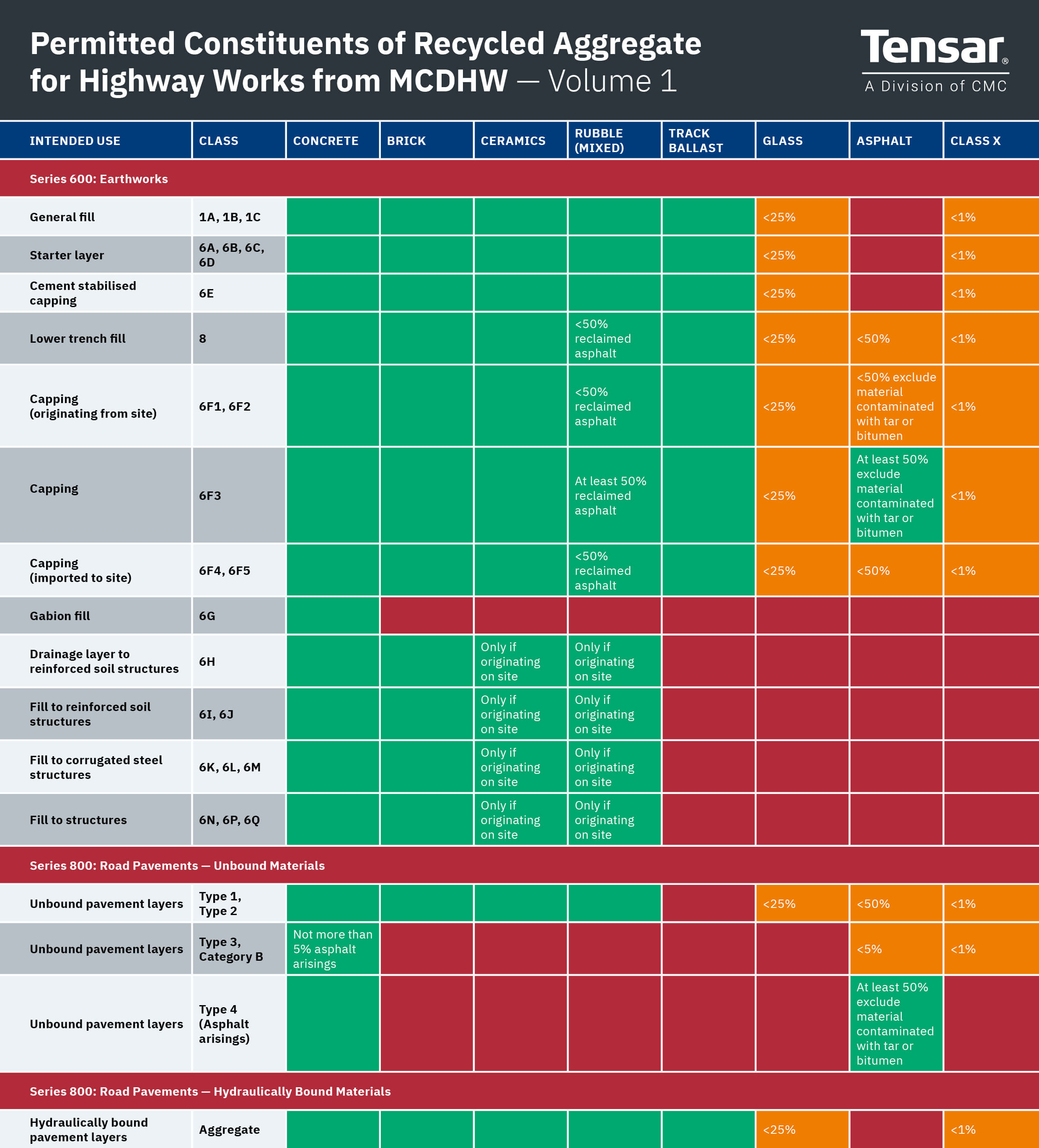.jpg)
Quality protocol for recycled aggregate
MCDHW Volume 1 stipulates that all recycled aggregates must be tested in accordance with Clause 710. The testing specified in this clause is surprisingly simple. The coarse particles must be hand sorted and classified by type, in accordance with BS EN 9331-11.
Clause 710 also stipulates that a quality control procedure must be in place. The requirement is that this must follow the ‘Quality Protocol for the production of aggregates from inert waste.’ This protocol was developed by the UK Environment Agency and WRAP (Waste Resources Action Programme) in consultation with other regulatory stakeholders. The protocol sets criteria for the production and use of aggregates from inert waste.
There are four main purposes of the Quality Protocol:
- Provide users with confidence that the recycled aggregate conforms to appropriate UK and European specification.
- Prove confidence that the recycled aggregate is suitable for use within a designated market sector.
- Clarifies at which point the material need no longer be classified as waste.
- Protect the environment and human health
Benefits of recycled aggregates
We’ve already seen how there are numerous benefits to using recycled aggregates in construction projects that go beyond sustainability. Whilst reducing a company's environmental footprint is one of the main draws, there’s so much more that recycled aggregates can offer. We’ve taken a deeper dive into some of the advantages of using recycled aggregates.
Cost-effective
By eliminating the need to source expensive primary aggregates and in some cases reducing the volume of CDEW transported away from site, switching to recycled aggregates reduces costs. This approach is part of the solution for companies looking to reduce costs without compromising the functionality and value of the project.
Sustainability
The use of recycled aggregates in construction minimises the amount of CDEW that ends up in a landfill, along with the carbon that would otherwise have been emitted through transporting it there. Reducing reliance on primary aggregate materials, which have high carbon costs, can help your organisation to meet its sustainability targets. See our guide on embodied carbon in construction to learn more and discover how Tensar solutions can help to reduce it.
Reduced energy consumption
Less energy is used in the production of recycled aggregate materials, when compared to the production and processing of primary aggregates. The upshot of this is clear: minimising energy usage helps companies to save on costs and carbon emissions.
Versatile
Highly versatile, recycled aggregates are accepted for a wide range of construction applications, from road pavements and unsurfaced roads to foundation support and reinforced soil walls and slopes. Looking to make more use of recycled materials on your next project? Contact us to find out how.
Durability, strength, resilience
Recycled aggregates can stack up with more expensive primary aggregates in terms of durability and strength, and ensure the full design life is achieved. Geogrids are ideal for stabilising recycled aggregates, ensuring that structures like working platforms and roads are sufficiently resilient to hold up against environmental stresses and heavy loads and to improve their resilience to the effects of clime change.
Helps keep up with demand
Using recycled aggregates helps to keep up with the growing demand for construction materials. The industry continues to expand whilst looking for more sustainable and cost-efficient materials to cut costs whilst working towards greener construction practices. Repurposing construction waste materials can support a more sustainable approach to construction whilst utilising all materials effectively. .jpg) The benefits of recycled aggregate use in construction
The benefits of recycled aggregate use in construction
Challenges of recycled aggregates
Although the benefits of using recycled aggregate are clear, their use can present challenges. Let’s look at some of them here.
Not always low cost
Whilst recycled aggregates can be cost-effective, they are not necessarily a low-cost option. In many parts of the UK, the cost of recycled aggregates is only just below that of primary aggregate. This is because they need to be processed, quality assured and transported. As the use of recycled aggregates gains acceptance in a market, supply becomes an issue and the price inevitably rises. However, the sustainability benefits remain compelling.
Quality assurance
Whilst using recycled aggregates is more environmentally friendly, the quality and variability of these materials could be an issue, There is potential for issues to arise with contamination, where the source CDEW contains undesirable materials, leading to the aggregate being unacceptable for use in construction. The key to preventing this is through appropriate quality assurance protocols that define selection, testing and certification of recycled aggregates to ensure they are suitable and meet the quality expectations for their intended use.
Availability
Another challenge is the availability of recycled aggregates, as acceptance and demand increases, the availability of as certain recycled aggregate types could be limited, especially if larger quantities of the same aggregate are needed. Aggregate produced form recycled materials can also vary in appearance and colour, which could affect the project's overall result in terms of aesthetics..
Case study: Royal Docks, London
Located alongside the Thames, Gallions Phase 3b development will provide 238 homes. Tensar value engineered a piling mat solution that significantly reduced the original platform thickness. Although recycled aggregates were used, they are expensive in London. Tensar’s solution greatly minimised the cost and disruption from importing the aggregate fill.
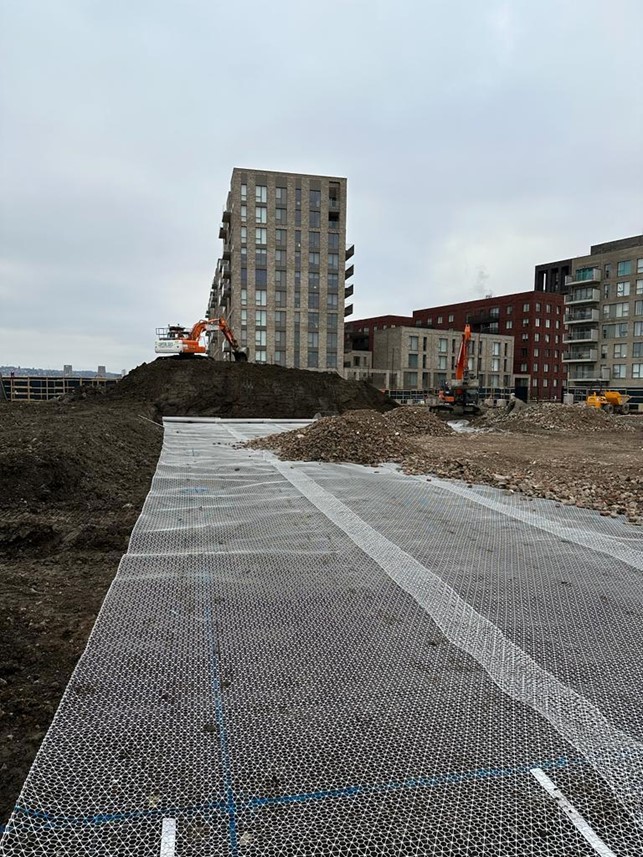
Tensar's value engineered design incorporating Tensar InterAx geogrid and recycled aggregate fill greatly reduced the cost of piling platforms on this London project.
How Tensar can help
This guide has introduced you to recycled aggregates, their uses in construction, and benefits. We’ve also explored how you can overcome some of the common challenges associated with using them and touched on a case study to bring this all to life.
Our free-to-use Tensar+ software can assist you in improving the material distribution and performance of recycled aggregates, providing insights into how we can support your next project. Tensar geogrids can also improve the effectiveness of applications such as embankments, roads, pavements, and retaining wall systems whilst utilising recycled aggregates and reducing the amount used.
If you have an upcoming project that could make use of recycled aggregates, get in touch with Tensar’s design team. We’ll produce a complimentary “Application Suggestion” to show how we can help you make cost and carbon savings.What are recycled aggregates?



